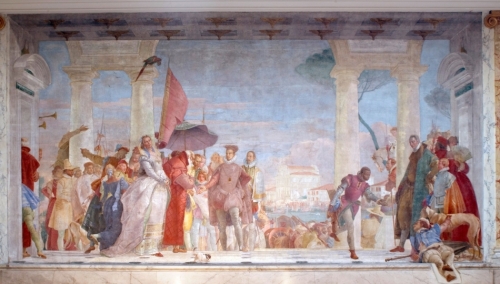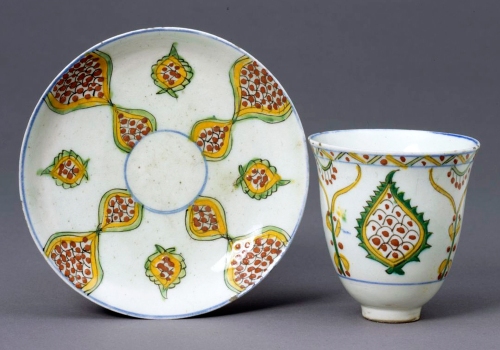Screw the Sistine Chapel: Kütahya Coffee Cups and the Canon
by Nandia Foteini Vlachou
.
When I first traveled abroad, I was already 25 years old – it felt like I was just old, especially for someone who was studying to be an art historian. It was in Paris that I went, as an Erasmus student in May 2000. I remember spending my first weeks there feeling actively rejected by the French capital, and with a sort of dread for all the things I had to do and see. I visited a lot of museums – by no means all of them – and the Louvre, repeatedly. I was then – in a sense, I still am – most interested in painting.

Giambattista Tiepolo, Henry III at the Contarini Villa in Venice, c. 1745, fresco, 729 x 402 cm, Musée Jacquemart-André, Paris (source: museum site)
.
In one of my non-Louvre visits, and non-Bibliothèque nationale study days, I visited a smaller museum, the Jacquemart-André. Of course, a ‘smaller’ museum in Paris, is still a museum that has a Venetian fresco by Tiepolo (the father), and I am not certain whether this was the main attraction for me to begin with (it seems I’ve been in love with the Tiepolo family as far back as I can remember, although it’s the son for whom I have the greatest affection).
I admired the brilliant Guardi, the rigid Uccello, and the curious-looking (probably due to excessive surface cleaning) Bellini. But the reason that the museum left an indelible impression is wholly unrelated to painting. At the time I visited it, the museum was hosting an exhibition of Ottoman ceramics, called Splendeurs de la Céramique Ottomane. Du XVIe au XIX siecle. I had not heard anything about Iznik pottery, ever. This was obviously a subject not covered by my master’s degree on European art. It was love at first sight. I don’t think I’ve ever gotten hit so hard by anything, aesthetically speaking (this must be the main reason the Gulbenkian museum later became one of my favorites museums).

Coffee cup and saucer from Kütayha, Turkey, 1700-1800, Victoria & Albert Museum, London (source: museum site)
.
I could not get enough of the objects – apart from the sixteenth-century Iznik ceramics on display, there were also Kütahya ceramics. Kütahya had a significant tradition in the production of coffee cups with distinct motifs, although in the nineteenth century Iznik motifs began to be re-utilized, probably as a result of international demand. I do not recall the details of the object that transfixed me in particular, other than the fact that it contained yellow – and that it was a coffee cup (it might have looked like the one from the V&A collection, in the photo above). I remember looking at it, intently. And then the thought just popped in my head, almost uninvited, and just lodged there: “Screw the Sistine Chapel” (although it sounded much ruder in my head).
Do not get me wrong, I do not claim that one cannot at the same time enjoy and appreciate Kütahya coffee cups and the Sistine Chapel – and I would be intellectually dishonest if I did not confess that I might not give a rat’s ass about the Sistine Chapel, but I care a great, great deal about the Stanze (I am a total fangirl for Raphael). I tried to explain to myself the unusual appeal of the object through its emotional hold: whether one might choose to call it Turkish or Greek, coffee for me signified the time that my mother would sit down and relax (knitting, too, although that involved manual labor). As someone who worked and also had to take care of a household with two kids, she did not have that much time. When she drank the coffee, she used to leave the cup on the kitchen table, instead of immediately placing it in the sink and washing it. It used to perplex me, until she told me that she liked to look at the cup with its dark sediment, and be reminded of having drank the coffee. There was pleasure in the memory of the action.
Yes, the coffee cup might have moved me because it reminded me of a specific ritual (I also remember my grandmother, who used to drink coffee prepared in a portable gas stove after she got up from her afternoon nap). But there was something else, besides the emotions it stirred in me. I marveled at how beautiful the coffee cup was, how frail, yet how lovingly made. I tried to imagine the anonymous craftsman that had produced it, the one that had drawn the delicate motifs, the one that had glazed it. I marveled at the skill applied. Yet the craftsman (note: not the artist) would forever remain anonymous. Would there have been a difference if there was a name attached to the cup? Any name? And why on earth did I not care sufficiently for Michelangelo? He did spent all those years perched on that scaffolding – that cannot have been easy.
This was for me the unexpected (perhaps even weird) beginning of an ongoing fascination for the workings, interrogation of the logic, and downright frustration towards the canon of western art. Eponymous vs. anonymous, the fine arts vs. the decorative arts (and I will have something more to say on this subject in an upcoming post), the West vs. the East, centers vs. peripheries, and so on. The canon works, as a value-generating and self-justifying structure, to obscure the fact that it proceeds through arbitrary hierarchies. Not only does it place unsurmountable obstacles to the understanding of any object (designated as art, sometimes also arbitrarily), it also places obstacles to their reception. Can people freely admit to not liking the Sistine Chapel? Or Picasso? (yeah, him too). Is that even an option?
There have been a lot of attempts (also ongoing) to expand or revise the canon, by including previously ignored, overlooked and under-represented material. The recent re-organization of the display of the permanent collection of the Centre Pompidou in Paris, called “Multiple Modernities“, is just such an attempt. But is there a chance the canon might become more comprehensive, more inclusive – less oppressive, less obfuscating? Or shall the canon burst? as Christopher B. Steiner perceptively wondered (in a June 1996 Art Bulletin article), while criticizing the tendency/desire to simply shove more things into it.
Well, I have a proposal. Let us neither expand, nor revise the canon. It is hopeless. Let’s just hurl it from a precipice, take a brief moment to mourn its passing, and get on with our lives. Screw the canon. Have a cup of coffee instead.
.

Simply beautiful…
LikeLike
For what it’s worth, I don’t have much love for the work of Picasso, and I have never been concerned about saying that.
I love the story of the coffee-drinking. It made me feel as if I was there, watching your mother looking at her cup.
Best wishes, Pete.
LikeLike